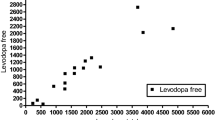Summary
To investigate the relation between “on-off” fluctuations in symptomatology and bioavailability of dopa in patients with Parkinson's disease, five Parkinsonian patients with pronounced “on-off” symptoms were studied. Continuously during the study the degree of disability in the patients was registered. Every one hour, and in addition, whenever there was a change from “on” to “off” or vice versa, a blood sample was collected for dopa determination. Since dopa is transported from plasma into the brain by a saturable carrier for which it has to compete with endogenous large neutral amino acids (LNAA), the concentrations of these competitors were measured too.
In four of the patients there were considerable oscillations in the plasma dopa concentration during the day; in one of these patients the highest value was as much as 12 times higher than the lowest value. These dramatic fluctuations in the absolute concentration of dopa in plasma had a major influence on the relative dopa concentrations (calculated as the ratio dopa/sum of LNAA) as the fluctuations in the concentrations of LNAA in plasma were much less pronounced. Consequently, the absolute and the relative concentrations of dopa in plasma were highly parallelled.
In four of the five patients “on”-periods began within one hour after a peak in the concentration of dopa in plasma and in the fifth patient five out of seven “on”-periods were preceded by a rise in plasma dopa concentration within the same time interval.
From the present data it could be concluded that the “on-off” phenomenon in Parkinson's disease, at least partly, is due to oscillations in the concentration of dopa in plasma. A reduction in the variations of the concentration of dopa in plasma seems to be necessary to overcome the “on-off” problem. The introduction of a slow release preparation of dopa is therefore urgently warranted. The concentration of LNAA in plasma must, however, also be considered in this context.
Similar content being viewed by others
References
Barbeau, A.: The clinical physiology of side effects in long-term L-dopa therapy. In: Advances in Neurology, Vol. 5 (McDowell, F. H., Barbeau, A., eds.), pp. 347–365. New York: Raven Press. 1974.
Carlsson, A.: Are “on-off” effects during chronic L-dopa treatment due to faulty feedback control of the nigrostriatal dopamine pathway? J. Neural Transm., Suppl.19, 153–161 (1983).
Fahn, S.: “On-off” phenomenon with levodopa therapy in parkinsonism. Neurology.24, 431–441 (1974).
Fernstrom, J. D.: Role of precursor availability in control of monoamine biosynthesis in brain. Physiological Reviews63, 484–546 (1983).
Freed, C. R., Asmus, P. A.: Brain tissue and plasma assay of L-dopa andα-methyldopa metabolites by high performance liquid chromatography with electrochemical detection. J. Neurochem.32, 163–168 (1979).
Granérus, A.-K.: Factors influencing the occurrence of “on-off” symptoms during long-term treatment with L-dopa. Acta Med. Scand.203, 75–85 (1978).
Hare, T. A., Beasley, B. L., Chambers, R. A., Boehme, D. H., Vogel, W. H.: Dopa and amino acid levels in plasma and cerebrospinal fluid of patients with Parkinson's disease before and during treatment with L-dopa. Clinica Chimica Acta45, 273–280 (1973).
Lewitt, P. A., Chase, T. N.: “On-off” effects: The new challenge in parkinsonism. Trends in Neuro Sciences6, 1–4 (1983).
Marsden, C. D.: “On-off” phenomena in Parkinson's disease. In: Parkinson's disease-Current progress, problems and management (Rinne, U. K., Klingler, M., Stamm, G., eds.), pp. 241–254. Amsterdam-New York: Elsevier/North-Holland Biomédical Press. 1980.
Muenter, M. D., Tyce, G. M.: L-dopa therapy of Parkinson's disease: Plasma L-dopa concentration, therapeutic response, and side effects. Mayo Clinic Proceedings46, 231–239 (1971).
Pardridge, W.: Regulation of amino acid availability to the brain. In: Nutrition and the brain (Wurtman, R. J., Wurtman, J. J., eds.), pp. 141–204. New York: Raven Press. 1977.
Quinn, N., Marsden, C. D., Parkes, J. D.: Complicated response fluctuations in Parkinson's disease: Response to intravenous infusion of levodopa. LancetII, 412–415 (1982).
Rinne, U. K., Sonninen, V., Siirtola, T.: Plasma concentration of levodopa in patients with Parkinson's disease. Europ. Neurol.10, 301–310 (1973).
Rinne, U. K.: Problems associated with long-term levodopa treatment of Parkinson's disease. Acta Neurol. Scand.68, Suppl.15, 19–26 (1983).
Sandler, M., Ruthven, C. R. J., Goodwin, B. L., Hunter, K. R., Stern, G. M.: Variation of levopoda metabolism with gastrointestinal absorption site. LancetI, 238–240 (1974).
Shoulson, I., Glaubiger, G. A., Chase, T. N.: On-off response; Clinical and biochemical correlations during oral and intravenous levodopa administration in parkinsonian patients. Neurology25, 1141–1148 (1975).
Sweet, R. D., McDowell, F. H.: Plasma dopa concentrations and the “on-off” effect after chronic treatment of Parkinson's disease. Neurology24, 953–956 (1974 a).
Sweet, R. D., McDowell, F. H.: The “on-off” response to chronic L-dopa treatment of Parkinsonism. In: Advances in Neurology, Vol. 5 (McDowell, F. H., Barbeau, A., eds.), pp. 331–338. New York: Raven Press. 1974, 1974 b.
Tolosa, E. S., Martin, W. E., Cohen, H. P., Jacobson, R. L.: Patterns of clinical response and plasma dopa levels in Parkinson's disease. Neurology25, 177–183 (1975).
Wade, D. N., Mearrick, P. T., Birkett, D. J., Morris, J.: Variability of L-dopa absorption in man. Aust. N.Z. J. Med.4, 138–143 (1974).
Woods, A. C., Glaubiger, G. A., Chase, T. N.: Sustained-release levodopa. LancetI, 1391 (1973).
Yahr, M. D.: Variations in the “on-off” effect. In: Advances in Neurology, Vol.5 (McDowell, F. H., Barbeau, A., eds.), pp. 397–404. New York: Raven Press. 1974.
Author information
Authors and Affiliations
Rights and permissions
About this article
Cite this article
Eriksson, T., Magnusson, T., Carlsson, A. et al. “On-off” phenomenon in Parkinson's disease: Correlation to the concentration of dopa in plasma. J. Neural Transmission 59, 229–240 (1984). https://doi.org/10.1007/BF01250010
Received:
Issue Date:
DOI: https://doi.org/10.1007/BF01250010




